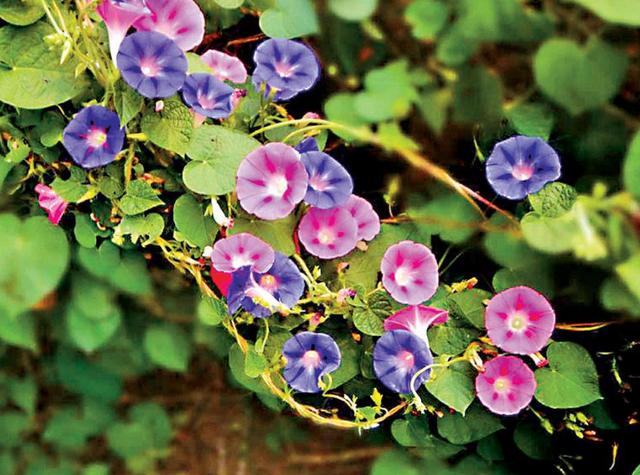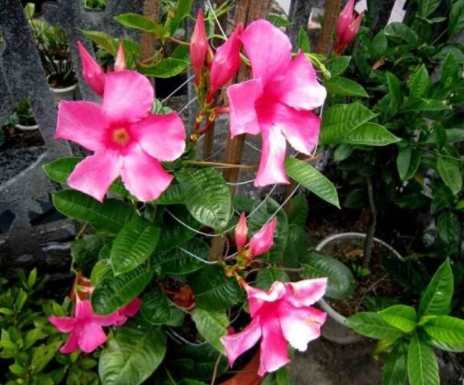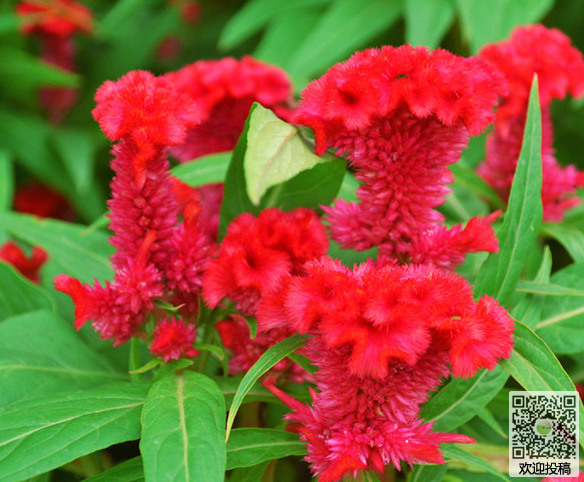When will morning glory be planted?
Planting skills of morning glory
Once the temperature drops for a day, morning glory blooms at night, usually between four and six. These trumpet-shaped flowers vary in yellow, red, white, pink or stripes, and plants should continue to bloom from spring to summer until a good frost. Plants can reach a height of 18 to 36 inches (46 to 91 centimeters) when planted outdoors, but can be slightly shorter when growing in containers.

Grow it in an outdoor garden
Wait until the weather is warm. It is planned to plant seeds after the end of spring, when the frost is in danger. Depending on where you live, this may be between early April and mid-May. Since the flowers grow at 4 o'clock, it is not necessary to start indoors as soon as possible. It is recommended that you wait until the weather gets warmer so that you can plant directly outdoors.
two。 Soak the seeds. The night before you plan to plant, put the seeds on a small plate and cover them with water. Soak the seeds in water overnight. The shells of these seeds are very thick, so they may not germinate if they are not thoroughly soaked. When ready, the seeds should be swollen but still solid. Please note that if you plant seeds during the rainy season, when the soil is completely wet, you can omit this step and plant the dried seeds directly in the soil.
3. 04:00 flowers are better if you choose a sunny place to plant in direct sunlight or light / local shadows. For better growth, choose a place where you are exposed to 4 to 6 hours of sunlight every day. Too many shadows can cause plants to become slim and may interfere with flower production.
4. Loosen the soil. Use small wipes or garden forks to dig the soil in the planting area. Loosen about 1 or 2 feet (0.3 or 0.6 meters) of soil. You don't need to modify the soil. Although these flowers are in full bloom and well drained soil, they can grow well in a variety of soil conditions even if the soil quality is poor.
5. Gently push the seed into the soil. Push each seed into the soil with your fingers so that it is no more than 1 inch (1.25 cm). Make sure the loose soil is covered with seeds to prevent weather and wildlife, especially birds. The depth of the soil should not exceed 1 stroke 2 inches (1.25 cm).
6. Separate the seeds 1 to 2 feet (0.30 to 0.61 meters). In general, only one seed should be sown per foot (30 cm). You eventually need to dilute the seedlings to separate the plants by 2 feet (0.61 meters). For this reason, you can also choose to sow 2 feet (0.61 meters) of seeds to save you extra money in the future.
7. The well. Water gently with spray cans or garden hoses. Make sure the soil is completely moist but not moist. Please note that seeds usually germinate within 7 to 14 days, depending on the temperature. Warm temperatures usually mean faster sprouting. When the seeds germinate, it is important for the soil to remain moderately moist. However, do not soak the soil, as this will remove the seeds.
Daily nursing
Dilute the seedlings. Once the seedlings are established, the plants will appear 2 feet (0.61 meters) between them.
If you plant the plant in a container or otherwise make the plant short and stunted, you can leave a distance of 8 to 12 inches (20 to 30 cm) between each seedling.
Wait until the stems of the seedlings begin to form two sets of leaves, and then dilute them. Keep the healthiest, strongest plants and eliminate the weakest plants.
Keep the soil moist. 04:00 flowers are drought-resistant, but they shouldn't stay dry for more than a day or two.
Try giving plants at least 1 inch (2.5cm) of water a week. Rain Water may water it with a hose or spray can.
Please note that flowers grown in containers require more regular watering than outdoor plants.
Apply mild fertilizer every month. Choose water-soluble multi-functional flower fertilizers that are applied before rainfall or when watering plants.
Choose a balanced 10-10-10 fertilizer that contains the same nitrogen, phosphorus and potassium. This fertilizer will promote the overall health of the plant.
Treat insects and diseases only when needed. 04:00 has very few insect and disease problems, so pretreatment is very frustrating.
If there is a problem, treat the plant with a suitable insecticide or fungicide. The product can be organic or chemical.
Consider digging tubers before winter. Every bush should plant large tubers underground. If you live in a mild climate, you should be able to put tubers on the ground without causing damage to plants. But if you live in a cold climate, you should dig for it at the end of autumn.
Tubers are stored between newspaper layers in cartons or wooden boxes. You can also store tubers in peat moss or sand. Do not use plastic containers or other closed boxes, as this may cause tubers to rot.
Put the tuber in a garage, hut, or similar environment. They should be dry and dark all winter.
Replant tubers in the spring. Dig a hole big enough to find tubers in the same place where you grew up. Put the tuber back on the ground, cover it with soil, and take care of the plant as before.
Consider covering the area with a cover. If you don't want to dig a tuber, you can usually protect it by covering an organically covered planting area of 1 or 2 inches (2.5 or 5 cm).
Organic mulch can include leaves, grass shavings, sawdust and newspapers.
The lid provides insulation and warms the soil slightly.
Please note that in cold climates, winter mulching may not be sufficient to protect tubers.
Have you learned the technique of planting morning glory? Come on, try it! Today's content is shared here, and we will see you next time!
Family planting methods of Petunia
Soil: petunia is suitable for slightly acidic soil, loose, breathable and well drained. Fully mixed with sandy loam and humus soil.
Temperature: petunia is sunny, afraid of frost and water. The suitable temperature for growth is 13-18 degrees. Don't be less than 4 degrees in winter. It can withstand the high temperature of 35 degrees in summer.
Fertilization: petunia has a long flowering period and needs nutrition. Apply cake fertilizer solution every ten days or so, and use potassium dihydrogen phosphate solution to fertilize potted soil in budding stage to promote flowers, flowers and color.
Watering: watering should be moderate, water evaporation in summer, should be timely watering, keep the soil moist and waterless.
Lighting: petunia needs strong light for a long time, and sunlight is good for the growth of petunia.
Pruning: when the seedlings reach 10cm, the core must be picked so that the lateral branches sprout and there are more buds. Flowers should cut off the remaining flowers and cut the branches, which will continue to bloom.
Plant petunias to control diseases and insect pests
Petunias (Petunia x hybrid) are annual summer petals that grow from spring to frost. Purple, pink, red, yellow or white flowers, petunia are suitable for many color schemes, often used in flower beds, flowerpots and gondolas. Petunia likes moist soil and partial hues. There are few pests involved in petunia, and the damage is usually not serious, so when you find black spots on the leaves of petunia, you usually do not need chemical pesticides.
Harvest seeds
The leaves of petunia are a little sticky and other seeds may fall off. In order to distinguish, it is better to remove this part of the seed, in order to avoid confusion with the real petunia seed.
Small black locust
Some mites are black and may look like spots on petunia leaves. Aphids can also be brown, yellow, green or red. They are small and soft, and some may have wings. They pierce parts of the plant with slender mouthparts and suck out the juice. Some mites usually do not do much harm. Severe infection of aphids can lead to stunting and yellow leaves. Aphids produce a sticky substance called honeydew, which attracts ants and promotes the growth of black smoke mold. Wash aphids from plants with mild water or water and soap.
Bud point
Worms and caterpillars often leave small spots on the leaves of petunia, called Foster. Petunia, also known as geraniums or tobacco night moths, usually feed on buds and petals. Damaged buds may not grow, or chewing and fragmentation may occur at the edge of flowering. The destruction of locusts is most obvious at the end of summer. Colors are usually similar to the colors of flowers, but they can also be green or brown. The most active dusk.
Hummer leaves feces.
There is usually a small amount of feces around the spots on the leaves of Petunia, indicating that thrips. Western flower thrips are the most common species of petunia. They ingest new organisms that are curled by flower buds and leaves, causing partial discoloration and deformation of the affected plants. Adult thrips are slender worms, long, narrow and striped. They can be black, brown, yellow, orange or white. Immature thrips are yellowish and have no wings. Pesticides can reduce the infection of thrips, but they can't get rid of them completely.
Time: 2019-05-08 Click:
- Prev

Culture methods and matters needing attention of Piaoxiang rattan
Incense vine is a kind of vine-like flower, the flower is large and colorful. Because it can give off the fragrance of flowers, it is called incense vine. Gorgeous and beautiful flowers are still welcomed by many people. The following editor introduces the breeding methods and matters needing attention of Tripterygium. I hope everyone likes them.
- Next

Flowering time and maintenance methods of Celosia cristata
The colors of cockscomb are bright red, orange, crimson, purple, white, red and yellow, and the leaves are dark red, emerald green, yellowish green, red green and so on. It is very popular in summer and autumn. When will it blossom? Let's take a look at the flowering time and curing method of cockscomb.
Related
- Fuxing push coffee new agricultural production and marketing class: lack of small-scale processing plants
- Jujube rice field leisure farm deep ploughing Yilan for five years to create a space for organic food and play
- Nongyu Farm-A trial of organic papaya for brave women with advanced technology
- Four points for attention in the prevention and control of diseases and insect pests of edible fungi
- How to add nutrient solution to Edible Fungi
- Is there any good way to control edible fungus mites?
- Open Inoculation Technology of Edible Fungi
- Is there any clever way to use fertilizer for edible fungus in winter?
- What agents are used to kill the pathogens of edible fungi in the mushroom shed?
- Rapid drying of Edible Fungi

